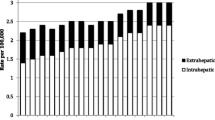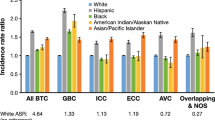Abstract
Background and Aims
It has been reported that the incidence of intrahepatic cholangiocarcinoma (ICC) has increased in the USA, while extrahepatic cholangiocarcinoma (ECC) has decreased or remained stable. However, neither the recent trends nor the effects of the misclassification of Klatskin tumors are known.
Methods
Using the Surveillance, Epidemiology, and End Results program databases, we calculated the average annual age-adjusted incidence rates (AA-IRs) of ICC and ECC in 4-year time periods (1992–1995, 1996–1999, 2000–2003, 2004–2007). These AA-IRs were calculated with misclassified as well as correctly classified Klatskin tumors. AA-IRs were also calculated based on age, sex, and race. Multivariable Poisson regression models were used to evaluate the secular trends of ICC and ECC.
Results
The AA-IR of ICC was 0.92 in 1992–1995 and 0.93 in 2004–2007, while the AA-IR of ECC increased from 0.70 in 1992–1995 to 0.95 in 2004–2007. There was no significant trend in AA-IR of ICC (p = 0.07), while there was a significant increase in ECC across the 4-year time periods (p < 0.001). Klatskin tumors comprised 6.7 % of CCs with approximately 90 and 45 % misclassified as ICC during 1992–2000 and 2001–2007, respectively. Adjusted Poisson models showed no significant differences in the temporal trend of ICC or ECC due to misclassification of Klatskin tumors.
Conclusions
The incidence of ICC has remained stable between 1992 and 2007 with only slight fluctuations, while the incidence of ECC has been increasing. Misclassification of Klatskin tumors does not appear to play a significant role in the trends of CCs.


Similar content being viewed by others
Abbreviations
- CC:
-
Cholangiocarcinoma
- ICC:
-
Intrahepatic cholangiocarcinoma
- ECC:
-
Extrahepatic cholangiocarcinoma
- WHO:
-
World Health Organization
- SEER:
-
Surveillance, Epidemiology, and End Results
- ICD-O:
-
International Classification of Diseases for Oncology
- AA-IR:
-
Age-adjusted incidence rate
References
Blechacz BR, Gores GJ. Cholangiocarcinoma. Clin Liver Dis. 2008;12:131–50, ix.
Gatto M, Bragazzi MC, Semeraro R, et al. Cholangiocarcinoma: update and future perspectives. Dig Liver Dis. 2010;42:253–260.
Shaib Y, El-Serag HB. The epidemiology of cholangiocarcinoma. Semin Liver Dis. 2004;24:115–125.
Tyson GL, El-Serag HB. Risk factors for cholangiocarcinoma. Hepatology. 2011;54:173–184.
Patel T. Cholangiocarcinoma. Nat Clin Pract Gastroenterol Hepatol. 2006;3:33–42.
Khan SA, Toledano MB, Taylor-Robinson SD. Epidemiology, risk factors, and pathogenesis of cholangiocarcinoma. HPB (Oxford). 2008;10:77–82.
Patel T. Worldwide trends in mortality from biliary tract malignancies. BMC Cancer. 2002;2:10.
Khan SA, Taylor-Robinson SD, Toledano MB, Beck A, Elliott P, Thomas HC. Changing international trends in mortality rates for liver, biliary and pancreatic tumours. J Hepatol. 2002;37:806–813.
Patel T. Increasing incidence and mortality of primary intrahepatic cholangiocarcinoma in the United States. Hepatology. 2001;33:1353–1357.
Welzel TM, McGlynn KA, Hsing AW, O’Brien TR, Pfeiffer RM. Impact of classification of hilar cholangiocarcinomas (Klatskin tumors) on the incidence of intra- and extrahepatic cholangiocarcinoma in the United States. J Natl Cancer Inst. 2006;98:873–875.
Carriaga MT, Henson DE. Liver, gallbladder, extrahepatic bile ducts, and pancreas. Cancer. 1995;75:171–190.
Surveillance, Epidemiology, and End Results (SEER) Program (www.seer.cancer.gov) Research Data (1973-2007), National Cancer Institute, DCCPS, Surveillance Research Program, Cancer Statistics Branch, released April 2010, based on the November 2009 submission. 2011.
Adamo MD, Johnson CH, Ruhl JL, Dickie LA. 2012 SEER Program Coding and Staging Manual. National Cancer Institute, NIH; 2012.
Khan SA, Emadossadaty S, Ladep NG, et al. Rising trends in cholangiocarcinoma: is the ICD classification system misleading us? J Hepatol. 2012;56:848–854.
Shaib YH, El-Serag HB, Davila JA, Morgan R, McGlynn KA. Risk factors of intrahepatic cholangiocarcinoma in the United States: a case-control study. Gastroenterology. 2005;128:620–626.
Shaib YH, El-Serag HB, Nooka AK, et al. Risk factors for intrahepatic and extrahepatic cholangiocarcinoma: a hospital-based case-control study. Am J Gastroenterol. 2007;102:1016–1021.
Shin HR, Oh JK, Lim MK, et al. Descriptive epidemiology of cholangiocarcinoma and clonorchiasis in Korea. J Korean Med Sci. 2010;25:1011–1016.
Welzel TM, Graubard BI, El-Serag HB, et al. Risk factors for intrahepatic and extrahepatic cholangiocarcinoma in the United States: a population-based case-control study. Clin Gastroenterol Hepatol. 2007;5:1221–1228.
Bertuccio P, Bosetti C, Levi F, Decarli A, Negri E, La Vecchia C. A comparison of trends in mortality from primary liver cancer and intrahepatic cholangiocarcinoma in Europe. Ann Oncol. 2013;24:1667–1674.
Acknowledgments
This work is partly funded by NIH Grant T32 DK083266-01A1, NIH Grant R01-CA-125487, NIH/National Institute of Diabetes and Digestive and Kidney Disease, Center Grant P30 DK56338 and the VA HSR&D Center for Innovations in Quality, Effectiveness and Safety (#CIN 13-413).
Conflict of interest
No conflicts of interest exist for Drs. Tyson, Ilyas, Duan, Green, Younes, El-Serag, or Davila.
Author information
Authors and Affiliations
Corresponding author
Additional information
Disclaimer: The views expressed in this article are those of the authors and do not necessarily represent the views of the Department of Veterans Affairs.
Rights and permissions
About this article
Cite this article
Tyson, G.L., Ilyas, J.A., Duan, Z. et al. Secular Trends in the Incidence of Cholangiocarcinoma in the USA and the Impact of Misclassification. Dig Dis Sci 59, 3103–3110 (2014). https://doi.org/10.1007/s10620-014-3276-2
Received:
Accepted:
Published:
Issue Date:
DOI: https://doi.org/10.1007/s10620-014-3276-2




